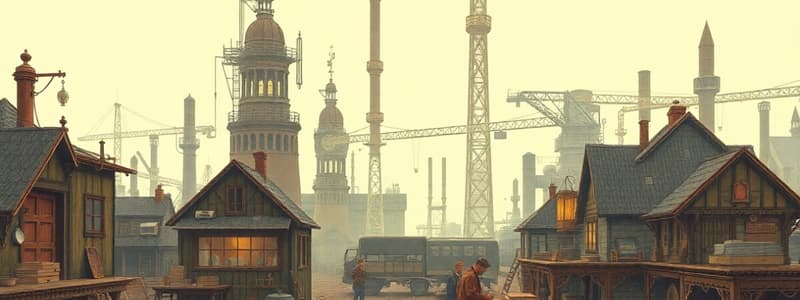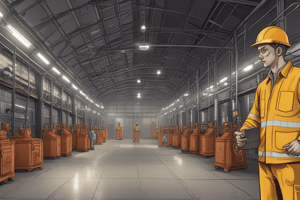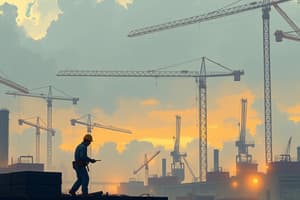Podcast
Questions and Answers
Which of the following fields does Industrial Relations draw upon?
Which of the following fields does Industrial Relations draw upon?
- Economics (correct)
- Anthropology
- Astronomy
- Philosophy
The majority of the Canadian labor force is made up of unionized workers.
The majority of the Canadian labor force is made up of unionized workers.
False (B)
What is one of the core concerns of Industrial Relations?
What is one of the core concerns of Industrial Relations?
Balancing the interests of management and workers.
Industrial Relations also examines the role of __________ as a regulator of the system.
Industrial Relations also examines the role of __________ as a regulator of the system.
What is a possible starting definition of Industrial Relations?
What is a possible starting definition of Industrial Relations?
Match the following disciplines with their primary focus:
Match the following disciplines with their primary focus:
All fields associated with Industrial Relations take a balanced view of workers' and management's interests.
All fields associated with Industrial Relations take a balanced view of workers' and management's interests.
Who proposed a broader definition of Industrial Relations that considers all aspects of the employment relationship?
Who proposed a broader definition of Industrial Relations that considers all aspects of the employment relationship?
What has happened to job security in recent years for new entrants in the workforce?
What has happened to job security in recent years for new entrants in the workforce?
The concept of industrial relations is solely focused on bargaining agreements.
The concept of industrial relations is solely focused on bargaining agreements.
What percentage of the Canadian workforce is now made up of women?
What percentage of the Canadian workforce is now made up of women?
Most of us derive virtually all of our income from __________________.
Most of us derive virtually all of our income from __________________.
Match the type of employment with its description:
Match the type of employment with its description:
Which of the following describes a characteristic of the modern Canadian workforce?
Which of the following describes a characteristic of the modern Canadian workforce?
Atypical forms of employment have decreased dramatically in Canada over the last two decades.
Atypical forms of employment have decreased dramatically in Canada over the last two decades.
What term describes employment that does not follow traditional full-time patterns?
What term describes employment that does not follow traditional full-time patterns?
What does Dunlop's systems theory include as part of an industrial relations system?
What does Dunlop's systems theory include as part of an industrial relations system?
According to Dunlop's systems theory, the government only plays a role as an employer and not as a regulator.
According to Dunlop's systems theory, the government only plays a role as an employer and not as a regulator.
Name one factor that can shift the balance of power between managers and workers.
Name one factor that can shift the balance of power between managers and workers.
What aspect does the systems theory fail to adequately address according to the criticisms mentioned?
What aspect does the systems theory fail to adequately address according to the criticisms mentioned?
Dunlop's systems theory states that IR systems include actors, contexts, a body of rules, and a common __________.
Dunlop's systems theory states that IR systems include actors, contexts, a body of rules, and a common __________.
Match the following components of Dunlop's systems theory with their correct descriptions:
Match the following components of Dunlop's systems theory with their correct descriptions:
The strategic choice framework emphasizes the importance of collective bargaining over management's role.
The strategic choice framework emphasizes the importance of collective bargaining over management's role.
Name one key element of the strategic choice framework.
Name one key element of the strategic choice framework.
Which of the following describes substantive rules in Dunlop's theory?
Which of the following describes substantive rules in Dunlop's theory?
Procedural rules and substantive rules in Dunlop's theory are mostly the same.
Procedural rules and substantive rules in Dunlop's theory are mostly the same.
The strategic choice framework arose from concerns about the emphasis on _____ in existing IR theories.
The strategic choice framework arose from concerns about the emphasis on _____ in existing IR theories.
According to the criticisms of the systems framework, what does it inaccurately assume regarding IR systems?
According to the criticisms of the systems framework, what does it inaccurately assume regarding IR systems?
What role does the government primarily play in an industrial relations system?
What role does the government primarily play in an industrial relations system?
Explain the significance of measuring conflict empirically within the strategic choice framework.
Explain the significance of measuring conflict empirically within the strategic choice framework.
Craig's modification of the systems framework was criticized for _____ the importance of workplace conflict.
Craig's modification of the systems framework was criticized for _____ the importance of workplace conflict.
Match the following elements with their descriptions:
Match the following elements with their descriptions:
What do institutionalists primarily focus on in their research?
What do institutionalists primarily focus on in their research?
Members of the reformist school believe that unions can effectively help workers in large organizations only.
Members of the reformist school believe that unions can effectively help workers in large organizations only.
What is the primary mission emphasized by members of the radical or political economy perspective?
What is the primary mission emphasized by members of the radical or political economy perspective?
The reformist school seeks major economic __________ to correct structural and political inequality.
The reformist school seeks major economic __________ to correct structural and political inequality.
Match the following perspectives with their beliefs:
Match the following perspectives with their beliefs:
What type of research method do institutionalists rely on more heavily compared to neo-classicists?
What type of research method do institutionalists rely on more heavily compared to neo-classicists?
The views of institutionalists about workplace conflict are completely dismissive.
The views of institutionalists about workplace conflict are completely dismissive.
What do members of the radical or political economy perspective think about unions?
What do members of the radical or political economy perspective think about unions?
Which perspective emphasizes the study of markets, especially labor markets?
Which perspective emphasizes the study of markets, especially labor markets?
Neoclassicists advocate for the use of unions and government regulation.
Neoclassicists advocate for the use of unions and government regulation.
What primary research tool do managerialists often use?
What primary research tool do managerialists often use?
The __________ perspective is taken by most mainline academic researchers in Industrial Relations.
The __________ perspective is taken by most mainline academic researchers in Industrial Relations.
Match the following perspectives with their key features:
Match the following perspectives with their key features:
Which perspective believes that conflict can be resolved through market forces?
Which perspective believes that conflict can be resolved through market forces?
Managerialists completely reject the idea that unions can play a positive role in industrial relations.
Managerialists completely reject the idea that unions can play a positive role in industrial relations.
Where do neoclassicists stand on the political spectrum?
Where do neoclassicists stand on the political spectrum?
Flashcards
What is Industrial Relations (IR)?
What is Industrial Relations (IR)?
Industrial Relations (IR) is the study of the relationship between employers, employees, and their representatives, focusing on issues like wages, working conditions, and employee rights.
Why is Work Important?
Why is Work Important?
Work holds immense significance in our lives, shaping our identity, providing economic security, and influencing our social connections.
What Makes IR Interdisciplinary?
What Makes IR Interdisciplinary?
IR is an interdisciplinary field, drawing insights from various disciplines like economics, sociology, and psychology.
Systems Framework of IR
Systems Framework of IR
Signup and view all the flashcards
Strategic Choice Framework of IR
Strategic Choice Framework of IR
Signup and view all the flashcards
Shifting Employment Trends
Shifting Employment Trends
Signup and view all the flashcards
Changing Composition of Canadian Workforce
Changing Composition of Canadian Workforce
Signup and view all the flashcards
Challenges in IR
Challenges in IR
Signup and view all the flashcards
Industrial Relations (IR)
Industrial Relations (IR)
Signup and view all the flashcards
Union
Union
Signup and view all the flashcards
Collective Bargaining
Collective Bargaining
Signup and view all the flashcards
Government's Role in IR
Government's Role in IR
Signup and view all the flashcards
Management Prerogative
Management Prerogative
Signup and view all the flashcards
Fairness in IR
Fairness in IR
Signup and view all the flashcards
Balancing Interests in IR
Balancing Interests in IR
Signup and view all the flashcards
Ergonomics
Ergonomics
Signup and view all the flashcards
Dunlop's Systems Theory
Dunlop's Systems Theory
Signup and view all the flashcards
Actors in Industrial Relations
Actors in Industrial Relations
Signup and view all the flashcards
Context in Industrial Relations
Context in Industrial Relations
Signup and view all the flashcards
Web of Rules in Industrial Relations
Web of Rules in Industrial Relations
Signup and view all the flashcards
Common Ideology in Industrial Relations
Common Ideology in Industrial Relations
Signup and view all the flashcards
Common Ideology in IR
Common Ideology in IR
Signup and view all the flashcards
Criticism of 'Common Ideology'
Criticism of 'Common Ideology'
Signup and view all the flashcards
Systems Framework
Systems Framework
Signup and view all the flashcards
Criticisms of Systems Theory
Criticisms of Systems Theory
Signup and view all the flashcards
Strategic Choice Framework (SCF)
Strategic Choice Framework (SCF)
Signup and view all the flashcards
SCF: Key Elements
SCF: Key Elements
Signup and view all the flashcards
SCF: Conflict Measurement
SCF: Conflict Measurement
Signup and view all the flashcards
Diverse IR Perspectives
Diverse IR Perspectives
Signup and view all the flashcards
Neoclassical Perspective
Neoclassical Perspective
Signup and view all the flashcards
Managerial Perspective
Managerial Perspective
Signup and view all the flashcards
Institutional (Orthodox Pluralist) Perspective
Institutional (Orthodox Pluralist) Perspective
Signup and view all the flashcards
Industrial Relations (IR) Framework
Industrial Relations (IR) Framework
Signup and view all the flashcards
Individual Importance of Unions
Individual Importance of Unions
Signup and view all the flashcards
Major Research Focus
Major Research Focus
Signup and view all the flashcards
Conflict in IR
Conflict in IR
Signup and view all the flashcards
Location on the Political Spectrum
Location on the Political Spectrum
Signup and view all the flashcards
Institutionalist Perspective
Institutionalist Perspective
Signup and view all the flashcards
Reformist Perspective
Reformist Perspective
Signup and view all the flashcards
Radical Perspective
Radical Perspective
Signup and view all the flashcards
Institutionalist View on Conflict
Institutionalist View on Conflict
Signup and view all the flashcards
Reformist View on Inequality
Reformist View on Inequality
Signup and view all the flashcards
Radical View on Inequality
Radical View on Inequality
Signup and view all the flashcards
Radical View on Unions
Radical View on Unions
Signup and view all the flashcards
Modified Radical View on Unions
Modified Radical View on Unions
Signup and view all the flashcards
Study Notes
Introduction to Industrial Relations (Labour Relations)
- Course aims to provide a brief introduction to the field of industrial relations (IR), also known as labour relations
- Significance of work in Canadians' lives is considered
- IR is interdisciplinary, drawing from multiple fields (economics, law, political science, history, psychology, sociology, business management, music, folklore, etc.)
- IR encompasses the relations between unions and management, but also government's role as regulator and the experiences of non-unionized workers
Significance of Work
- Work shapes adult identity and is a major source of income, impacting daily life
- Relationships often form at work
- The global work environment has drastically changed
- Full-time, full-year jobs are less common
- Part-time, casual, contractual, and home-based work are increasingly prevalent
- Job security is less reliable for today's workers compared to previous generations
What is Industrial Relations/Labour Relations?
- IR analyzes phenomena like differing union membership rates across countries
- Relevant fields in IR analysis include economics, law, political science, and sociology
- Defining IR is complex due to its interdisciplinary nature
- Defining IR includes: the relationships between management and unions; the regulatory role of government; and the experiences of both unionized and non-unionized workers, encompassing various groups like children and retired persons
Theories of Industrial Relations
- Dunlop's systems theory is a significant IR theory
- It comprises actors (managers, workers, and government), contexts (economic, technical, and power), rules governing behavior, and a unifying ideology.
Dunlop's Systems Theory - Detailed Description
- Actors: Management, workers, representatives, and government
- Contexts: Economic, technical, power, and political.
- Rules: Substantive (pay, benefits, safety) and procedural (grievances, strikes.)
- Ideology: Common values and belief systems
- Theory highlights interconnections and balances of power between actors within a system
Critiques of Dunlop's System Theory
- "Common Ideology" lacks practical guidance
- Minimizes importance of environmental inputs and conflict
- Doesn't fully account for the dynamism of IR systems and the potential for conflict.
Perspectives on IR
-
Five perspectives exist among IR academics:
- Neo-classical (emphasizes economics and markets)
- Managerial (Focuses on worker motivation and engagement in business)
- Institutional (recognizes worker/employer power imbalances and stresses union/employer bargaining structures)
- Reformist (advocates for increased worker power)
- Political Economy (views inequality as inherent in capitalism)
-
These perspectives offer diverse views on a range of issues in labour and workplace relations.
Studying That Suits You
Use AI to generate personalized quizzes and flashcards to suit your learning preferences.




